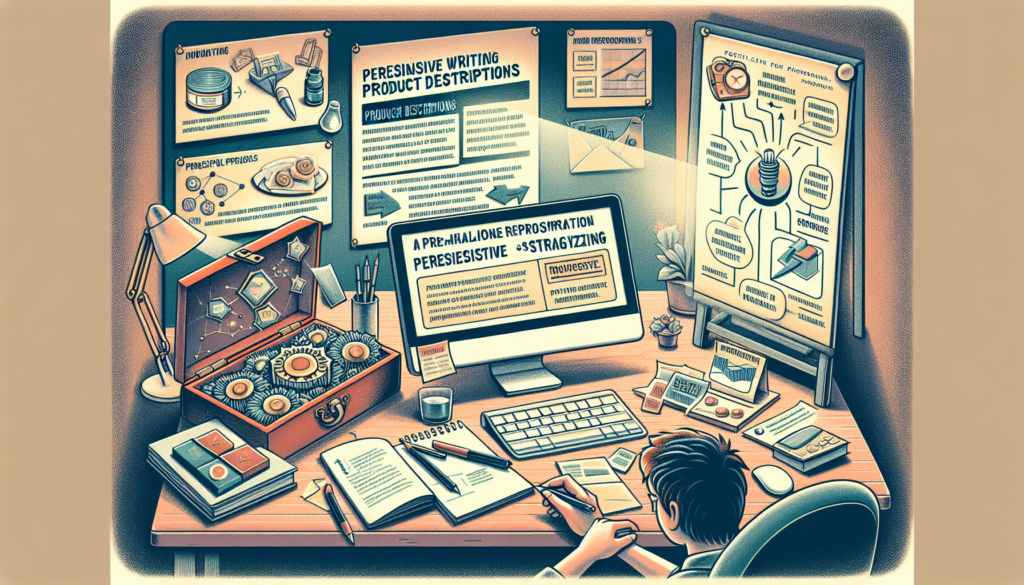When it comes to selling products, a well-written description can make all the difference. The art of crafting a product description lies in its ability to captivate potential customers and convince them that this item is exactly what they need. In this article, you will discover effective strategies for writing product descriptions that not only highlight the key features and benefits but also highlight the unique selling points that set the product apart from the competition. Get ready to master the art of persuasive product descriptions and boost your sales to new heights!
Crafting a Compelling Headline
Choosing attention-grabbing words
When crafting a compelling headline for your product description, it’s important to choose attention-grabbing words that pique the interest of your potential customers. Words like “exclusive,” “innovative,” or “must-have” can create excitement and curiosity.
Including product name and key benefit
Include the product name in your headline to ensure clarity and immediate identification. Additionally, highlighting a key benefit of the product in the headline will instantly convey value to the reader.
Using numbers or statistics
Numbers and statistics can be powerful tools to grab attention and create credibility. Including specific numbers or statistics in your headline can make your product description more persuasive and compelling.
Creating a sense of urgency
To encourage immediate action, creating a sense of urgency in your headline can be highly effective. Phrases like “limited time offer,” “act now,” or “while supplies last” can create a sense of urgency and motivate the reader to make a purchase.
Understanding Your Target Audience
Identifying demographics and psychographics
To create product descriptions that resonate with your target audience, it’s crucial to have a deep understanding of their demographics and psychographics. Demographics include factors such as age, gender, location, and income, while psychographics explore their interests, values, and lifestyle.
Researching customer pain points and motivations
By researching your target audience’s pain points and motivations, you can address their needs and desires directly in your product description. Understanding what problems your product solves or what benefits it provides will help you speak directly to your customers’ desires.
Tailoring language and tone to match audience preferences
To effectively engage your target audience, your product description’s language and tone should align with their preferences. Consider whether your audience prefers a formal or informal tone, and use language that resonates with them to establish a connection.
Highlighting benefits that resonate with the target market
While features are important to showcase, focusing on the benefits of your product that resonate with your target market is crucial. Highlighting how your product can improve their lives, solve their problems, or fulfill their desires will capture their attention and motivate them to consider a purchase.

Focusing on Key Features
Listing important specifications
When describing your product’s key features, start by listing important specifications. Include details such as size, weight, color options, or any unique features that set your product apart. This provides factual information that potential customers look for in a product description.
Explaining how features solve customer problems
After listing the specifications, explain how each feature solves specific customer problems or meets their needs. This helps potential buyers understand the practical benefits of each feature and how it enhances their experience with the product.
Prioritizing unique or standout features
If your product has unique or standout features, make sure to prioritize them in your description. These features differentiate your product from competitors’ offerings and can be strong selling points. Emphasize how these features make your product stand out and provide added value to customers.
Showing the Benefits
Identifying primary benefits for customers
To create powerful product descriptions, it’s essential to identify the primary benefits your product offers to customers. Think about the main reasons why someone would want to purchase your product and focus on highlighting those benefits throughout your description.
Demonstrating how the product fulfills customer needs
Once you’ve identified the primary benefits, demonstrate how your product fulfills the specific needs of your customers. Share examples or anecdotes that illustrate how your product has helped solve common problems or improve lives. This helps potential buyers envision themselves experiencing the same benefits.
Using storytelling techniques to engage readers
Storytelling is a powerful tool in product descriptions as it allows you to engage readers on an emotional level. Use storytelling techniques to describe scenarios or situations where your product comes in handy, creating a narrative that resonates with your target audience.
Highlighting the emotional and practical advantages
In addition to practical advantages, it’s crucial to highlight the emotional benefits of your product as well. Consider how your product makes customers feel or how it improves their quality of life. By appealing to both the practical and emotional aspects, you create a well-rounded description that appeals to a wider range of customers.

Using Persuasive Language and Tone
Creating a positive and enthusiastic tone
When writing your product description, make sure to adopt a positive and enthusiastic tone. The tone sets the mood for your description and influences how readers perceive your product. An upbeat and enthusiastic tone can help create excitement and increase the likelihood of a purchase.
Employing power words and sensory language
To make your product description more persuasive, employ power words and sensory language that evoke strong emotions. Words like “amazing,” “luxurious,” or “transformative” can make your product sound more appealing. Additionally, using sensory language to describe how your product looks, feels, or smells can make it more tangible for potential customers.
Addressing customer objections or concerns preemptively
To build trust and overcome potential objections, try to address customer concerns or objections preemptively in your description. Anticipate potential hesitations your customers may have and provide reassurances or explanations that alleviate those concerns, making it easier for them to make a purchasing decision.
Including social proof and testimonials
Social proof and testimonials can be highly persuasive in product descriptions. Include customer reviews or testimonials that highlight positive experiences with your product. This helps build credibility and trust among potential buyers, increasing their confidence in making a purchase.
Structuring the Description
Keeping paragraphs short and readable
To ensure readability, keep your paragraphs short and concise. Long paragraphs can be overwhelming and discourage potential customers from reading the entire description. Aim for 2-3 sentences per paragraph to maintain a visually appealing layout.
Using bullet points or subheadings for easy scanning
Make your product description easy to scan by using bullet points or subheadings to highlight key information. This improves readability and allows potential buyers to quickly find the information they are looking for, saving them time and effort.
Organizing information in a logical flow
To ensure coherence and clarity, organize your product description in a logical flow. Start with an introduction that grabs attention, followed by the key features, benefits, and any additional information. Ending with a strong call-to-action encourages potential buyers to take the next step.
Avoiding jargon or technical language
While it’s important to provide accurate information, avoid using jargon or technical language that the average customer may not understand. Keep your product description accessible to a wide audience, using simple and clear language that everyone can easily comprehend.
Optimizing for Search Engines
Conducting keyword research
To optimize your product description for search engines, conduct keyword research to understand what terms potential customers are using when searching for products like yours. Identify relevant keywords that align with your product and incorporate them naturally throughout your description.
Incorporating relevant keywords naturally
Once you have identified relevant keywords, incorporate them naturally into your product description. Avoid keyword stuffing, as this can negatively impact the readability and flow of your description. Ensure that the keywords seamlessly fit within the context to provide valuable information to both readers and search engines.
Writing unique and original descriptions
Search engines value unique and original content. Avoid duplicating product descriptions from other sources, as this can harm your search engine rankings. Craft unique descriptions for each product, providing valuable information that sets your description apart from competitors.
Avoiding duplicate content
As mentioned before, duplicate content can negatively impact your search engine rankings. Ensure that each of your product descriptions is unique and distinct from one another. This not only improves your search engine visibility but also provides a better user experience for potential customers who may be comparing similar products.
Promoting Brand Authenticity
Reflecting the brand’s voice and personality
When crafting product descriptions, it’s important to reflect your brand’s voice and personality. Consistency in tone and language across all your brand’s communications helps to establish a cohesive and authentic identity that resonates with customers.
Describing the brand’s mission or values
Incorporate your brand’s mission or values into your product descriptions to add depth and meaning. This gives your potential customers a better understanding of your brand’s purpose and vision, creating a connection that goes beyond just selling a product.
Engaging with customers through storytelling
Storytelling is a powerful tool for engaging customers and building brand loyalty. Use storytelling techniques within your product descriptions to create an emotional connection with your audience. Share the story behind your brand or product, allowing your customers to feel a deeper connection and investment in your offerings.
Creating a Visual Experience
Using descriptive language to paint a vivid picture
In addition to product images or videos, use descriptive language to paint a vivid picture of your product in the customer’s mind. Describe the visual details, colors, textures, or any other characteristics that make your product visually appealing. This helps potential customers imagine themselves using and enjoying your product.
Including high-quality product images or videos
Visuals play a significant role in product descriptions. Include high-quality product images or videos that showcase your product from different angles and perspectives. This allows potential customers to get a closer look and make more informed purchasing decisions.
Highlighting visual details and aesthetic appeal
Pay attention to the visual details of your product and highlight them in your description. Whether it’s the sleek design, intricate craftsmanship, or vibrant colors, emphasize the aesthetic appeal to captivate potential buyers. Visual details can often be the deciding factor for customers who prioritize aesthetics.
Formatting and Proofreading
Checking for grammar, spelling, and punctuation errors
Ensure your product description is free of grammar, spelling, and punctuation errors. Mistakes can undermine the professionalism and credibility of your brand. Proofread your description carefully, or consider having someone else review it before publishing.
Ensuring consistency in tone and style
Consistency in tone and style across all your product descriptions helps build brand recognition and trust. Make sure the language, tone, and style align with your brand guidelines. This ensures that customers have a cohesive experience throughout their interaction with your brand.
Applying proper formatting for readability
Formatting plays a crucial role in the readability of your product descriptions. Use proper formatting techniques such as headings, subheadings, bullet points, and paragraphs to break up the text and make it more scannable. This improves the overall user experience and keeps potential buyers engaged.
Adding white space and headers for scannability
To make your product description more scannable and visually appealing, incorporate white space and headers. White space helps prevent information overload, while headers help guide the reader’s attention and allow for easy navigation. A well-structured description enhances readability and improves the overall user experience.



